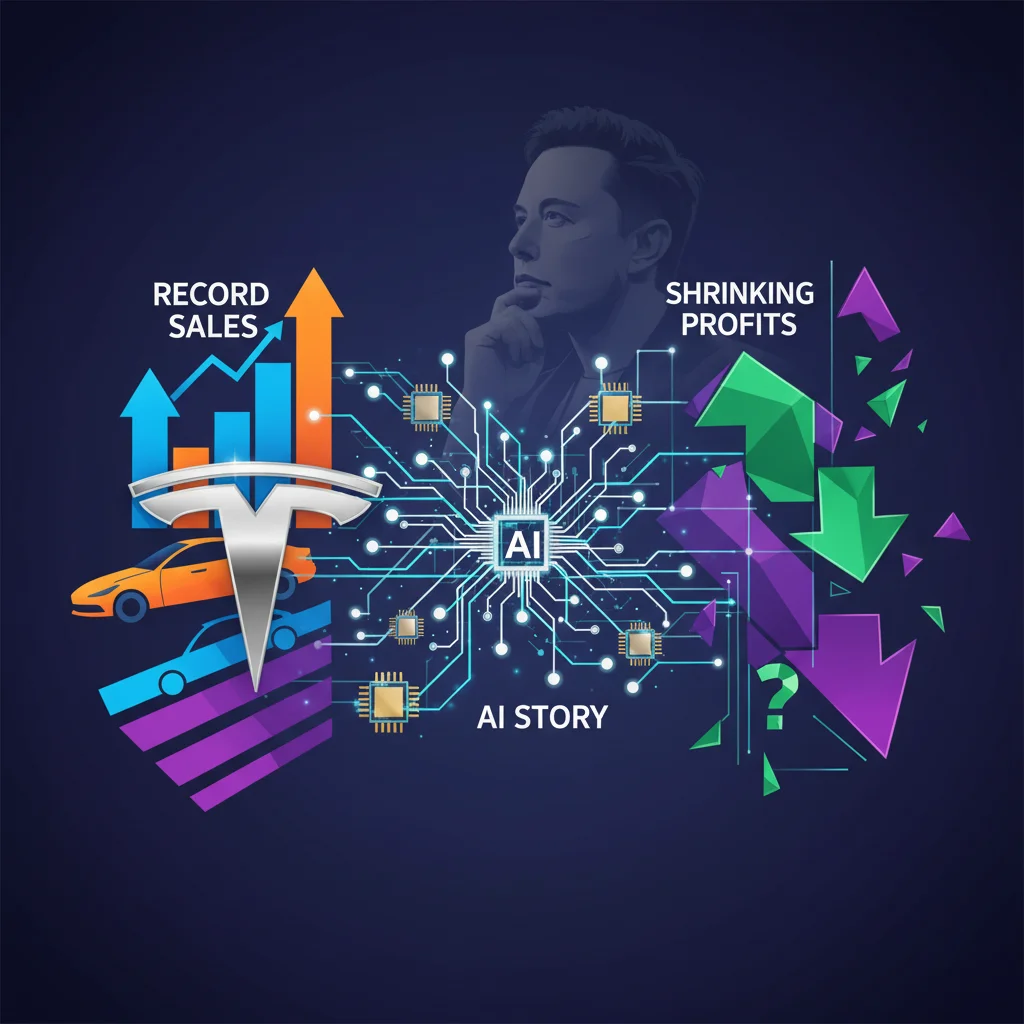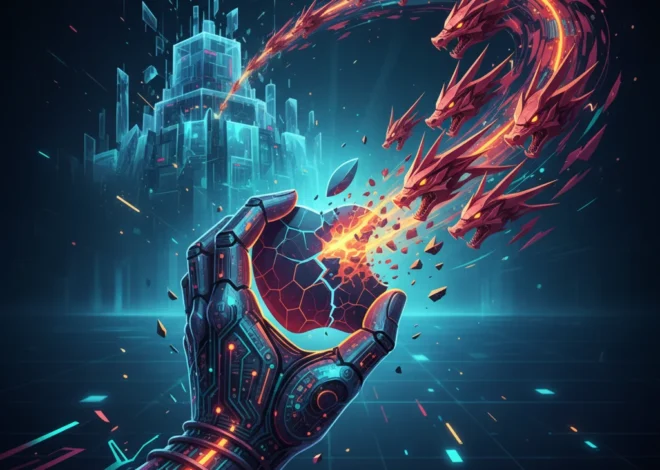
Tesla’s Profit Puzzle: Why Record Sales Don’t Tell the Whole AI Story
It’s a headline that seems to defy business logic: a company reports record-breaking revenue, yet its profits are shrinking. This is the curious case of Tesla’s latest financial report. While Elon Musk’s electric vehicle powerhouse saw a surge in sales, driven by US buyers rushing to claim a key tax credit, the bottom line tells a more complex, and frankly, more interesting story. According to a report from the BBC, this revenue-profit disconnect has left investors and analysts buzzing.
But to see this merely as a story about car sales and profit margins is to miss the forest for the trees. For developers, tech professionals, and entrepreneurs, Tesla’s current financial state is not just a quarterly report; it’s a real-time case study in a high-stakes pivot. It’s about a company sacrificing today’s profitability for tomorrow’s dominance in a future defined not by horsepower, but by processing power, artificial intelligence, and autonomous software.
Let’s peel back the layers of this financial paradox and explore what it truly reveals about Tesla’s grand strategy, the competitive landscape, and the monumental role that software, AI, and automation play in its quest to redefine mobility.
The Numbers Game: Deconstructing the Revenue-Profit Paradox
On the surface, the numbers paint a conflicting picture. The company celebrated record revenue, a direct result of a savvy consumer base capitalizing on government incentives before they changed. This created a significant, albeit temporary, surge in demand (source). However, this revenue spike came at a cost.
Throughout the year, Tesla initiated a series of aggressive price cuts across its model lineup. This was a strategic move with two primary goals: first, to maintain its competitive edge against a growing army of EV contenders from both legacy automakers and nimble startups; and second, to make its vehicles eligible for incentives like the US tax credit, thereby stimulating volume. While the strategy succeeded in boosting deliveries, it inevitably squeezed profit margins per vehicle.
Here’s a simplified look at the dynamic Tesla is navigating:
| Factor | Impact on Revenue | Impact on Profit Margin | Strategic Rationale |
|---|---|---|---|
| Aggressive Price Cuts | Neutral to Positive (by stimulating volume) | Negative | Market share defense, volume growth, competitive pressure |
| US Tax Credit Rush | Strongly Positive | Neutral | Capitalizing on a short-term market incentive |
| Increased Production Scale | Positive | Positive (in the long term) | Economies of scale, lowering per-unit production cost |
| R&D Investment (AI, FSD) | Neutral (in the short term) | Negative | Long-term investment in high-margin software and autonomy |
This trade-off—sacrificing per-unit profit for market penetration and fleet growth—is a classic tech playbook move. Amazon did it for years in e-commerce, and Netflix did it in streaming. The goal isn’t just to sell a product; it’s to build an ecosystem. For Tesla, every car sold is more than a one-time transaction; it’s a data-gathering node for its ambitious AI network.
The Billion Handshake: Why Tech Giants Are Buying the Physical 'Warehouses' of the AI Revolution
Beyond the Assembly Line: Tesla’s Trillion-Dollar Bet on AI and Software
This is where the story pivots from a car company’s financials to a tech giant’s moonshot. The shrinking profit margins on the physical cars are, in Tesla’s grand vision, a necessary cost to fund and fuel a much more lucrative endgame: solving autonomous driving and becoming a leader in applied artificial intelligence.
Full Self-Driving (FSD): The Ultimate SaaS Play
Tesla’s Full Self-Driving package is the company’s clearest example of a SaaS (Software as a Service) model. For a one-time fee or a monthly subscription, customers unlock advanced driver-assist features. Unlike a physical component, the value of this software can increase over time through over-the-air updates. The gross margin on a software sale is astronomically higher than on a physical car. If Tesla can deliver on its promise of a truly autonomous system, the FSD software could become the single most valuable component of the vehicle, transforming the company’s entire financial structure.
Machine Learning at Unprecedented Scale
Every Tesla on the road is a sensor-laden device, collecting vast amounts of real-world driving data. This data is the lifeblood of its machine learning models. The company uses this fleet data to train the neural networks that power Autopilot and FSD. This creates a powerful feedback loop: more cars on the road mean more data, which leads to a smarter AI, which in turn makes the cars more desirable. This data advantage is a significant moat against competitors who lack a comparable real-world dataset. The entire operation relies on a sophisticated cloud infrastructure to process and manage petabytes of video and sensor data.
Innovation in Automation and Programming
Tesla’s focus on innovation extends deep into its manufacturing process. The “Giga Press” machines that cast large sections of a car’s body in a single piece are a marvel of industrial automation. This drive to automate and simplify manufacturing is a software problem as much as it is a hardware one. It requires immense sophistication in robotics, control systems, and factory OS programming to orchestrate thousands of components into a seamless production line. This relentless pursuit of efficiency is crucial for eventually restoring and growing margins, even with lower vehicle prices.
The Competitive Battlefield: More Than Just a Car Race
Tesla’s price cuts weren’t made in a vacuum. The EV landscape is now fiercely competitive, and the threats are coming from all sides.
- Legacy Automakers: Giants like Ford, GM, Volkswagen, and Hyundai have committed tens of billions of dollars to electrification. They are leveraging their manufacturing expertise and brand loyalty to launch compelling EVs, rapidly closing the gap in range and performance.
- EV Startups: Companies like Rivian and Lucid are pushing the boundaries of performance and luxury, proving that innovation isn’t exclusive to Tesla. These startups, however, face their own immense challenges in scaling production profitably.
- Chinese Competitors: Perhaps the most significant long-term challenge comes from Chinese automakers like BYD, NIO, and XPeng. They are incredibly agile, vertically integrated, and operate in the world’s largest EV market, allowing for rapid iteration and cost reduction. They are also formidable players in software and in-car technology.
In this crowded market, robust cybersecurity becomes a critical differentiator. As vehicles become more connected and software-defined, protecting them from remote threats is paramount. A major security breach could be an existential threat to any brand in this space, making cybersecurity a core pillar of automotive engineering, not an afterthought.
Capita's £14m Nightmare: A Data Breach Wake-Up Call for Every SaaS, Startup, and Enterprise
The Road Ahead: Navigating Production Ramps and AI Timelines
So, what does the future hold? Tesla’s path forward is defined by a few key challenges and opportunities that will be closely watched by the entire tech and auto industries.
- Scaling New Platforms: The production ramp-up of the Cybertruck and future next-generation vehicles will be a major test of Tesla’s manufacturing and automation prowess. As the BBC notes, a company’s financial health is often tied to its ability to launch new products efficiently. Any stumbles here could further impact profitability.
- Delivering on the AI Promise: Ultimately, Tesla’s long-term valuation hinges on its ability to make significant, demonstrable progress with FSD. The transition from an advanced driver-assist system to a fully autonomous “robotaxi” is a monumental leap in AI and programming complexity. The world is watching to see if, and when, they can cross that chasm.
- Diversification: While vehicles get the headlines, Tesla’s Energy division (Megapack storage solutions and solar) represents a massive, high-growth market that leverages the company’s expertise in battery technology and software. This could become a crucial pillar of profitability in the years to come.
For tech professionals, Tesla’s journey offers a compelling glimpse into the future of engineering. It’s a world where mechanical, electrical, and software engineering are deeply intertwined, and where expertise in machine learning, data infrastructure, and secure cloud architecture are just as important as an understanding of vehicle dynamics.
From Stun Guns to Smart Clouds: The AI-Powered Future of Taser Technology
Conclusion: A Calculated Gamble on a Software-Defined Future
The story of Tesla’s sliding profits despite record revenue is far more than a simple financial report. It’s a clear signal of a company doubling down on its foundational bet: that the future of the automobile is software. By strategically sacrificing short-term margins, Tesla is growing its global fleet, the data-collecting network that fuels its artificial intelligence ambitions.
This path is fraught with risk. The competition is intensifying, the economic climate is uncertain, and the technical challenges of creating true autonomy are immense. But if the gamble pays off, Tesla won’t just be the world’s leading EV maker; it will have successfully transformed into a defining AI and robotics company of the 21st century. The latest financial report, with all its contradictions, is simply one more chapter in that audacious story.


